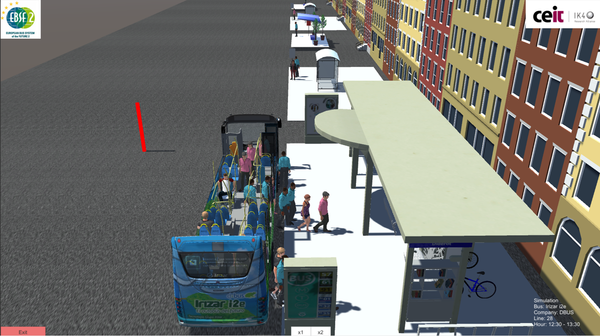Improving bus layouts through 3D simulation of passengers’ behaviours

Bus lines can target distinct profiles of passengers. For example, bus lines serving university areas need higher capacity and faster buses to serve young people at rush hours. Contrarily, during off-peak hours, bus lines serving market areas might require buses with more seats and a higher level of comfort.
Bus lines can target distinct profiles of passengers. For example, bus lines serving university areas need higher capacity and faster buses to serve young people at rush hours. Contrarily, during off-peak hours, bus lines serving market areas might require buses with more seats and a higher level of comfort.
Applying the same layout to all bus services is not the answer. Differences in terms of age, physical abilities and journey expectations should be taken into account to design bus layouts (e.g. seat arrangements, size and position of doors) as well as bus stops to optimize the flow of passengers on board and during boarding and alighting.
Within the EBSF_2 project, CEIT-IK4 has developed a 3D Bus Passenger Simulation Tool (BPST) to evaluate bus layout designs from the passengers’ perspective. The BPST takes advantage of an agent based simulation to investigate the behaviour of categories of passengers with distinct needs and requirements.
Up to nine behaviours have been modelled to target elderly passengers, teenagers, middle-age men and women and young families with children. Pram and wheel chair users are also included. Within the simulation, the virtual passengers behave and make decisions as in real life: they wait at the bus stop, they board through their preferred door, and, depending on their preferences and the availability of seats, they decide where to sit. If no seats are available, they will remain standing.
Different layouts for bus and bus stop can be assessed thank to this approach and the benefits evaluated by means of the flow of passengers. To this end, the BPST estimates the total dwell time and the entry and exit time per door. The analysis can be done for one single bus stop or for a complete bus line. Policies of the local operator can be simulated as well: boarding only through the front door or through all the doors, ticket validation on-board, etc.
The BPST can import original 3D CAD drawings of the vehicle and bus stop to be analysed. When this is not available, the tool features an l editor to model a bus layout in a very simple way.
Within EBSF_2, the BPST has been applied in San Sebastian, Spain, to test the layout of three buses operating along four lines, with diverse bus stop configurations. . The bus manufacturer Irizar and the local public transport operator DBUS are actively working together with CEIT-IK4 to evaluate the benefits in terms of accessibility, passengers’ satisfaction and improved operational performances. Results will be published according to the project work plan.
Author: Ángel Suescun






